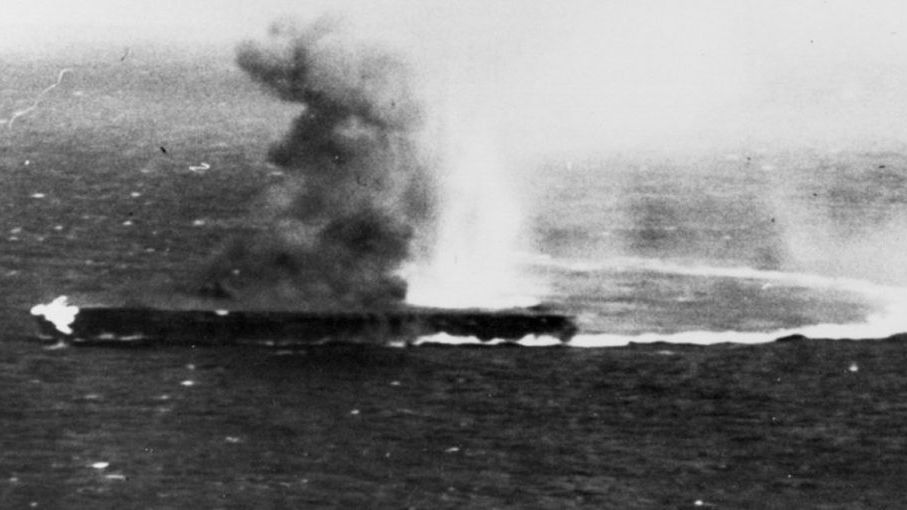Remembering the Battle of the Coral Sea

Seventy-five years ago, on May 12, 1942, American submarines inflicted the final major casualties of the Battle of the Coral Sea, a fight that tested the skill of the U.S. Navy on, under and above the sea.
The Battle of the Coral Sea etched names in American history and heritage: Rear Adm. Frank Jack Fletcher, Lt. “Jo Jo” Powers, Lt. Milton Ricketts, Dauntlesses Devastators aircraft, USS Hammann (DDG 412), USS Neosho (AO 23), USS Lexington (CV 2) and USS Yorktown (CV 5). The enemy sank the carrier USS Lexington and so badly damaged another carrier, USS Yorktown, that they thought it too was lost.

A mushroom cloud rises after a heavy explosion on board USS Lexington (CV 2), May 8, 1942. This is probably the great explosion from the detonation of torpedo warheads stowed in the starboard side of the hangar, aft, that followed an explosion amidships at 5:27 p.m. Note USS Yorktown (CV 5) on the horizon in the left center, and destroyer USS Hammann (DD 412) at the extreme left. (U.S. Navy photo/Released)
On May 27, Yorktown made it back into the Pearl Harbor channel and eased into drydock at the Pearl Harbor Naval Shipyard, met by Adm. Chester Nimitz, who conducted an immediate inspection.
Back then, sailors and civilians were still in recovery mode after the attacks of Dec. 7, 1941. Shipyard workers were repairing hulls, propellers and pumps on damaged ships.
Simultaneously, ashore at what is now known as Joint Base Pearl Harbor-Hickam, preparations were underway for the battle that would turn the tides in America’s favor in the war in the Pacific.
While Imperial Japan felt emboldened and confident after the destruction the Japanese inflicted to our Pacific Fleet battleships, we were quietly getting ready to engage in multiple domains, including cyber, through codebreaking.
At Station Hypo in Building One, Navy code breakers, led by Lt. Cmdr. Edwin Layton and Lt. Cmdr. Joe Rochefort, provided intelligence to Nimitz about the enemy’s plans to attack Midway Atoll. The surprise, combined with luck and courage, would give the Americans the edge despite the armada they faced at Midway.
Meanwhile, at the Pearl Harbor Naval Shipyard, civilians who had already been working for months to salvage, recover and repair warships in the harbor, would have to perform a miracle for Yorktown.

View of damage on USS Yorktown’s third and fourth decks, amidships, caused by a 250 kilogram bomb hit received during the Battle of Coral Sea. This view looks forward and to starboard from the ship’s centerline at frame 110. The large hole in the deck was made by the bomb’s explosion. Many men were killed or badly injured in compartment C-301-L, a crew’s messing space that was the assembly area for the ship’s engineering repair party. (U.S. Navy)
Nimitz ordered the ship to be ready in three days.
According to historian Thomas Cutler, “civilian yard workers swarmed aboard armed with a different arsenal of war – hammers, acetylene torches and the like – and soon the ship echoed with a cacophony of frantic but purposeful activity. Working around the clock in temperatures sometimes reaching 120 degrees, these workers labored in an eerie world of pulsating light, choking smoke, pungent fumes and a racing clock. Three days later, the resurrection was complete. Yorktown steamed down the channel, headed for sea and ‘rendezvous with destiny,’ civilian workers spilling from her insides into small boats alongside as she went.”
Cutler said the U.S. Navy’s victory at the Battle of Midway is shared by those workers here at Pearl Harbor. “The miracle began when others fought exhaustion and the clock to do the seemingly impossible.”
The war in the Pacific started in Pearl Harbor and so did the comeback. After Midway, our Sailors and Marines continued to fight across the Pacific and northward from Guadalcanal, eventually defeating Imperial Japan and setting the stage for greater freedom, democracy and prosperity.
Rear Adm. Fuller is finishing up his tour as commander of Navy Region Hawaii and Naval Surface Group Middle Pacific. He is slated to become commander of Carrier Strike Group 1 this summer.
This article appears courtesy of U.S. Navy Live and may be found in its original form here.
The opinions expressed herein are the author's and not necessarily those of The Maritime Executive.
